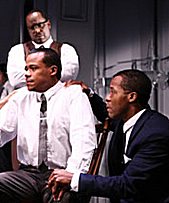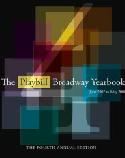SITE GUIDE
SEARCH
REVIEWS
REVIEW ARCHIVES
ADVERTISING AT CURTAINUP
FEATURES
NEWS
Etcetera and
Short Term Listings
LISTINGS
Broadway
Off-Broadway
NYC Restaurants
BOOKS and CDs
OTHER PLACES
Berkshires
London
California
New Jersey
Philadelphia
Elsewhere
QUOTES
TKTS
PLAYWRIGHTS' ALBUMS
LETTERS TO EDITOR
FILM
LINKS
MISCELLANEOUS
Free Updates
Masthead
A CurtainUp Review
The Good Negro
By Elyse Sommer
|
Love is the only power and love will
lead us to freedom. .— James Lawrence
|

>l-r (front) Le Roy McClain, Curtis McClarin (rear) J. Bernard Calloway in The Good Negro
(Photo credit: Joan Marcus) |
When Ms. Wilson began working on the play four years ago, Barrack Obama's presidency was still something of an impossible dream. Naturally, opening in New York (the play is a co-venture with the Dallas Theater Center where it premiered last year) during the first 100 days of the Obama administration, gives The Good Negro a very special relevance. More importantly it once again proves that Wilson is more than a fact gatherer. As in The Story, she doesn't just lean on actual events but knows how to transform them into a ripping good story presented with all-around dramatic flair.
While the terrible bombing of a church in Alabama that killed four teenaged girls is probably Wilson's creative wellspring, it's best not to let your attention wander to dovetailing the play's events with 1960s headline-making stories. Instead, just sit back and let yourself get caught up in Wilson's fictionalized version of that history making time.
The two characters most evidently resembling real people are Rev. James Lawrence (Curtis McClarin) and Henry Evans (J. Bernard Calloway). Lawrence is an obvious stand-in for Martin Luther King Jr. —but with more attention paid to the flawed human beneath the plaster saint image that has attached itself to King's memory. The role model for Henry Evans is the Reverend Ralph Abernathy, King's most devoted follower who nevertheless often threatened to resign from the Movement.
Both McClarin and Calloway give forceful performances, but the play's richness and dramatic impact derives from Wilson's inventiveness in creating her own vivid characters — white as well as black — to make The Good Negro a dynamic narrative. Even the easily recognizable James and Henry aren't carbon copies of the Reverends King and Abernathy. McLarin's Martin Luther King-like James is a compellingly complex and very human character — a charismatic leader, yet full of self-doubt; a happily married man with a hard to control need to regularly "see a doctor" (a code term by Henry for his friend and colleague's adulterous encounters with women).
Lawrence's frailties serve as a set-up for putting the interlaced stories in the context of 1963 Birmingham where the Klu Klux Klan and Jim Crow laws were still firmly entrenched and the Civil Rights leadership was desperately looking for continued support and for something to propel them forward. His peccadillos test the love and loyalty of his colleagues, affect the marriage of the young woman who provides the organization with the cause they've been looking for, and gives fodder to the two FBI agents who are secretly taping the Movement leaders conversations in order to come up with something to undo their cause.
The Public Theater's intimate yet grand Lu Esther Hall echoes the play's structure of an epic viewed through the lens of individual stories. It's a setting that enables scenic designer Clint Ramos to create a large scale feeling to a simple scenic design — a lectern and a few strategically positioned tables and chairs on a deep wooden platform raised high enough but not too high for the actors to enter and exit at either side and to create a sense of the audience being not just onlookers but participants in the unfolding struggle for equal rights.
Director Liesl Tommy's makes good use of this large but sparely furnished set to cross-cut between the three-way plot, letting the action shift fluidly from talk about an event to showing it actually happening. This overlapping begins with James upstage addressing his followers with a speech that recognizes them being "tired of being called names, tired of being beaten, tired of water hoses and dogs, tired of loving in the face of hate". As he's speaking, just such a discouragingly hateful event is acted out: Claudette Sullivan (Joniece Abbott Pratt), a young black mother who sent her 4-year-old daughter to a store's white restroom rather than use the alley, is abused first by a white bigot (Brian Wallace) and then by a policeman (Quincy Dunn Baker) —all this as a sales woman in the store has her child taken away to a police station where she's kept in a holding cell for six hour.
Claudette's mistreatment becomes the play's pivot. It brings fresh energy to the Movement, including a new recruit, Bill Rutherford (LeRoy McClain). Rutherford is an educated young black man who has taken a leave from his job as an account executive for a large corporation in Geneva, Switzerland to lend his managerial knowhow to a cause on behalf of the uneducated Southerners with whom he doesn't really identify. It's Rutherford who is most troubled by the aspects of James's behavior that put the Movement at risk,
While Lawrence, Evans and Rutherford have no trouble getting Claudette to agree to speak out about how she and her child were traumatized, her husband Pelzie (Francois Battiste) is another matter. Hopelessness is too ingrained for him to believe speaking out can spell anything but trouble. The strain their opposing opinions puts on the marriage is exacerbated by his growing awareness that James has taken a very personal interest in her.
Besides the scenes that makes us witness to the three Movement leaders' backstage squabbles and the Claudette/Pelzie story, the play periodically segues to Paul Moore (Quincy Dunn Baker)) and Steve Lane (Brian Wallace), the FBI operatives assigned to keep tabs on the Movement leaders. These guys actually provide a good deal of quirky humor with their commentary on what they overhear. When Rutherford comes on scene, Steve and Paul express amazement that he left a posh and freer life in Europe. When Paul comments that "Negroes in Europe got it better than most white people here," Steve comments "Well, I guess they should all go to Europe then. . .that would fix everything. " Their relationship with "The Old Man" (an unseen J. Edgar Hoover) and occasional Keystone Cops incompetency also adds to their being this play's Shakespearian clowns.
As already mentioned, the entire ensemble does fine work, but there are several standouts. I especially admired Francois Battiste, who was also outstanding in last summer's premiere of Broke-ology, another powerful play about African-Americans (review). Battiste's Pelzie could easily be a stereotype of an uneducated black man, but is instead a believable portrait of a cautious man who sees protest actions as a sure signal for a violent backlash but whose love for his wife endures even when the trouble he anticipates materializes. Of the three ministers J. Bernard Callaway's volatile Henry is the most colorful. Erik Jensen is memorably despicable as the redneck the FBI duo forces to be their KuKluxKlan informer.
Ramos, wearing his second hat as the show's costume designer has created the right period look for the actors, and lighting designer, Lap Chi Chu ably supports the directorial vision for showing one or more actors even as a current scene is still being played out. While some of those scenes might benefit from some editing, there really aren't any dull spots and the more than two-and-a-half hours sped by a lot faster for me than some eighty and ninety -minute plays I've seen.
To read the review of Tracey Scott Williams' The Story go here
|
The Good Negro By Tracey Scott Wilson Directed by Liesl Tommy Cast: Joniece Abbott-Pratt (Claudette Sullivan), Francois Battiste (Pelzie Sullivan), J. Bernard Calloway (Henry Evans), Quincy Dunn-Baker (Policeman 2), Erik Jensen (Gary Thomas Rowe), LeRoy McClain (Bill Rutherford), Curtis McClarin (James Lawrence), Rachel Nicks (Corinne Lawrence), Brian Wallace (Steve Lane & Policeman 1) Scenic and costume design: Clint Ramos Lighting design: Lap Chi Chu Sound design by Daniel Baker Hair & Makeup design: Jon Carter Stage Manager Sally Sibson The Public Theater, Lafayette Street From 3/03/09; opening 3/16/09; closing 4/19/09 Running Time: 2 hours and 45 minutes, including one intermission Reviewed by Elyse Sommer at 3/14 press performance |
|
REVIEW FEEDBACK Highlight one of the responses below and click "copy" or"CTRL+C"
Paste the highlighted text into the subject line (CTRL+ V): Feel free to add detailed comments in the body of the email. . .also the names and emails of any friends to whom you'd like us to forward a copy of this review. You can also contact us at Curtainup at Facebook or Curtainup at Twitter |
Try onlineseats.com for great seats to
Wicked
Jersey Boys
The Little Mermaid
Lion King
Shrek The Musical

South Pacific

In the Heights

Playbill 2007-08 Yearbook

Leonard Maltin's 2008 Movie Guide


Wicked
Jersey Boys
The Little Mermaid
Lion King
Shrek The Musical

South Pacific

In the Heights

Playbill 2007-08 Yearbook

Leonard Maltin's 2008 Movie Guide


